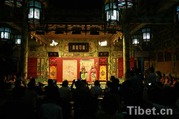Aga and cultural relic preservation

"Aga" is a kind of traditional Tibetan architectural craft for the roof or floor inside of a house. It is made from clay and crushed stones that locals call "aga soil" (a kind of highland soil) mixed with water and then laid out on the ground or on the roof, and is then repeatedly, stomped on manually to make it solid and smooth, so that no water can leak through. Groups of workers hold wooden tamps (on the bottom is a round block of stone, the top is a straight stick) to beat the aga soil, continuously singing labor songs while stomping the floor or rooftop. Singing keeps the workers’ steps in time, and the sound of the wooden tamps stomping on the ground keeps the beat; round after round of chorus, this is what it means to "stomp aga".
During the "aga" stomping process, much-needed labor groups coordinate together, and the songs can make the strenuous and mechanical physical labor easier, lively, and improves labor efficiency. It also helps the workers maintain good mental states, and reduces the amount of physical exertion. Therefore, the songs and dance that accompany the "aga" stomp has become a kind of unique cultural landscape. "Aga" stomp songs are mostly drawn from folk songs.
"Aga" and cultural preservation are closely related. The protection and preservation of Tibet’s ancient architecture has received attention for a long time. Tibet has always insisted on restoring ancient architecture to its original forms, especially during the course of preservation projects. Traditional Tibetan architectural crafts led by "Aga" has always been used in the renovation and preservation for ancient architecture's
Your Comment
Name E-mailRelated News
-
;
-
-

-
Tibet to increase investment in cultural relic preservation
Tibet will put greater efforts into cultural relic preservation; the investment in the cultural relic preservation will be more than 80% bigger than that during the 12th Five-Year Plan.
-
-
-

-
Endangered Tibetan talking-singing art recorded for preservation
The culture department in southwest China's Tibet Autonomous Region has finished recording a traditional folk talking and singing performance in order to preserve the dying tradition, the regional cultural protection center announced on Monday.
-
-
-

-
Monasteries become centers of artistic preservation
The Palcho Monastery, the main Buddhist establishment in Gyangze county in the southwest of the Tibet autonomous region, is famous for its stunning architecture and large numbers of religious murals.
-
-
-
Tibetan relic preservation enters digital era
The preservation of Tibetan relics has entered the digital era. The program has achieved initial results, Oct.28.
-
Based in Lhasa, Tibet Vista is a Tibet travel agency that specialized in Tibet permit, and Tibet tours for both private and group travelers at a local price!
•4 Days Lhasa City Group Tour from USD 460 •8 Days Everest Base Camp Group Tour from USD 850 •15 Days Mt.Kailash Group Tour from USD 1780 •2016 Tibet Train Tours from Beijing, Shanghai, Chengdu, Xining,etc










